F1 2013 – Review
by Edward
|
 After an intense last-minute shoot-out, you find yourself on Pole Position, with your closest championship rivals both to your right and immediately behind you. As you line up on the grid, you begin to worry; what if you flood the clutch and get a bad start? What if your tyres don’t last, or you’re taken off going into the first corner? What if you get your braking zone wrong and you go flying into the gravel-trap? You’ve already taken countless laps around the circuit, but suddenly confidence turns to nervousness, then immediately back to focus, as the five red lights appear and subsequently fade out. After an amazing start retaining position and keeping your cool, your tyres start to reach the cliff, and you decide that pitting a lap earlier than you’d planned will suffice, and it’s a move that seems to pay dividends as rivals start diving into the pit-lane and leaving an open expanse of road ahead.
After an intense last-minute shoot-out, you find yourself on Pole Position, with your closest championship rivals both to your right and immediately behind you. As you line up on the grid, you begin to worry; what if you flood the clutch and get a bad start? What if your tyres don’t last, or you’re taken off going into the first corner? What if you get your braking zone wrong and you go flying into the gravel-trap? You’ve already taken countless laps around the circuit, but suddenly confidence turns to nervousness, then immediately back to focus, as the five red lights appear and subsequently fade out. After an amazing start retaining position and keeping your cool, your tyres start to reach the cliff, and you decide that pitting a lap earlier than you’d planned will suffice, and it’s a move that seems to pay dividends as rivals start diving into the pit-lane and leaving an open expanse of road ahead.
However, with only a few laps to go, disaster strikes and, despite attempts to treat them kindly, the tyres have worn out with three laps to go. An emergency pit-stop and manic dash through the mid-field on fresh rubber later, and you’ve seen your stunning, career-defining pole result in the last point up for grabs; from top of the pecking order to begging for scraps. The frustration in the garage is palpable as the weekend target is missed and rivals edge ever-closer to toppling your position at the top of the leader-board. As the motorcade moves on to the next race, an exciting opportunity presents itself in the form of a contract, as Red Bull want you to move from Enstone-based Lotus to the domineering Austrian outfit. Ladies and Gentleman, welcome to F1 2013.
This season has seen Vettel absolutely dominate to the point that the remaining races appear to be a foregone conclusion and, as inevitability turns to reality, the results aren’t as fun to watch as they have been in previous years. Instead, the excitement has been more focused on Codemasters’ latest yearly iteration of the pinnacle of motorsports, and although they could easily have gone the route of updating the drivers, slapping on a new number and calling it a day, they’ve instead refined the formula and provided the most compelling sports title of the year.
 It all starts with the Young Driver’s Test, which acts as the tutorial to ease new players into the action. While many of the tests and videos are taken verbatim from last year’s effort, there are several new tests to help better familiarise yourself with the mechanics, and there’s one particular addition that helps make it a vital part of your time with F1 2013. After completing some of the tests, you’ll be given a medal based on your performance, and the teams available to choose from in Career mode are solely dependent on the amount of medals collected. Acquiring the bare minimum of medals will only garner you a position in Marussia or Caterham – neither of whom have ever scored points in their four years on the grid – while garnering gold left, right and centre will see you able to choose between any constructor up to, and including, Lotus, who placed fourth in last year’s championship.
It all starts with the Young Driver’s Test, which acts as the tutorial to ease new players into the action. While many of the tests and videos are taken verbatim from last year’s effort, there are several new tests to help better familiarise yourself with the mechanics, and there’s one particular addition that helps make it a vital part of your time with F1 2013. After completing some of the tests, you’ll be given a medal based on your performance, and the teams available to choose from in Career mode are solely dependent on the amount of medals collected. Acquiring the bare minimum of medals will only garner you a position in Marussia or Caterham – neither of whom have ever scored points in their four years on the grid – while garnering gold left, right and centre will see you able to choose between any constructor up to, and including, Lotus, who placed fourth in last year’s championship.
Once the Test is over, you can then choose whether to progress with your Career, but my first port of call was the new Scenario mode. Replacing last year’s Champions mode – tasking you with besting the most successful drivers on that year’s grid – players are instead given a specific objective and only a few laps with which to complete it. Each of these challenges are based on either a previous event in the sport, such as Button’s triumphant win in the wet over Vettel in Montreal, or based purely on fantasy or ‘what-if’ scenarios. There’s a massive variety of situations to put you through your paces and hone specific skills, but the same tracks tend to crop up again and again, with a couple of tracks noticeable by their exclusion. Admittedly, you can breeze the majority of the challenges without breaking a sweat if you’re looking for just a bronze award, but if you’re looking to achieve gold in every scenario then this will easily keep you entertained for a long time to come, and will prove to be one of F1 2013′s greatest additions.
 |
 |
 |
 |
 |
 |
Far more conspicuous an inclusion is the long-awaited Classics mode, allowing players to take to the tarmac with vehicles from F1′s long and storied history. The standard release comes with five vehicles from the eighties – as well as Lauda’s 1976 Ferrari featured in the latest Ron Howard epic Rush – while cars from the nineties are available as downloadable content or as part of the Classic Edition. Both the standard and Classic versions come with additional circuits, with the eighties content coming with Jerez and Brands Hatch, while Estoril and Imola will be available alongside the nineties content. For some added variety, retro cars can also drive on this season’s circuits and this year’s competitors are able to take to the older tracks, so if you ever wanted to see if Hamilton could best Alonso at San Marino or if Mansell could whip Andretti at Singapore, the world’s your oyster.
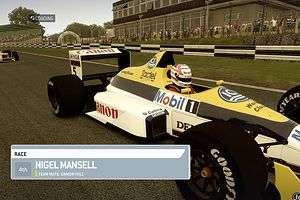 The amount of effort that’s gone into replicating these vehicles is incredible, and each of them behave so differently to their modern counterparts that it’ll take you a while to master their nuances. In particular, I found myself enamoured with the 1986 Lotus, which bucks like a mule every time it accelerates and is almost nightmarish to drive in the wet as a result. There are some very notable absences, especially the 1988 McLaren – a vehicle responsible for fifteen of sixteen race wins that year – considering that three of the five classic cars are all from that year, but there’s still enough variety that you could race for a while to come.
The amount of effort that’s gone into replicating these vehicles is incredible, and each of them behave so differently to their modern counterparts that it’ll take you a while to master their nuances. In particular, I found myself enamoured with the 1986 Lotus, which bucks like a mule every time it accelerates and is almost nightmarish to drive in the wet as a result. There are some very notable absences, especially the 1988 McLaren – a vehicle responsible for fifteen of sixteen race wins that year – considering that three of the five classic cars are all from that year, but there’s still enough variety that you could race for a while to come.
It won’t keep its grip on you forever though, and with only three scenarios that utilise the classics in the base content, you’ll find yourself abandoning this mode before long, even if Murray Walker makes a long-awaited return to set up each challenge. It could well be that the nineties content is even more fun to drive and will prove to ensnare your attention for far longer, but with the base eighties content provided, Classics mode feels more experimental than fully-realised.
Where players will then spend the bulk of their time is in the obligatory Career mode, where players can choose between the teams they unlocked through the Young Driver’s Test and launch their own bid for championship glory. With the rules and specifications remaining mostly rigid between this year and last, the most readily-apparent changes are the absence of the ugly stepped nose-cones and the ability to only activate the Drag-Reduction System on designated straights during practice and qualifying, not just the race. The latter change is one that I personally found most welcome, as I lost count last year of the amount of times I’d end up binning the car because I’d misjudged the best time to turn on the DRS, only to struggle in qualifying if I played it too safe.
 Although there’s been very few changes when it comes to rules, when it comes to the on-track action, F1 2013 feels like an almost-entirely different beast in comparison to its predecessors. While many would expect the action to look and feel relatively similar to before, there’s enough tweaks and nuances to this year’s entry that helps it leap and bound above Codemasters’ previous efforts. For one, the racing this year does a greater job of making the everything feel faster; 2012 had moments where I found myself getting bored and losing concentration, but 2013 is so much faster that driving in the tight street-circuit Monaco went from an occasionally-boring excursion to a challenge so quick and intense that I’d easily put trying to master the track as one of my scariest gaming moments of the year. Lara Croft may have had to survive on an island full of murderers, but she’s never had to keep all four wheels on a Lotus approaching Sainte Dévote at 160 miles an hour.
Although there’s been very few changes when it comes to rules, when it comes to the on-track action, F1 2013 feels like an almost-entirely different beast in comparison to its predecessors. While many would expect the action to look and feel relatively similar to before, there’s enough tweaks and nuances to this year’s entry that helps it leap and bound above Codemasters’ previous efforts. For one, the racing this year does a greater job of making the everything feel faster; 2012 had moments where I found myself getting bored and losing concentration, but 2013 is so much faster that driving in the tight street-circuit Monaco went from an occasionally-boring excursion to a challenge so quick and intense that I’d easily put trying to master the track as one of my scariest gaming moments of the year. Lara Croft may have had to survive on an island full of murderers, but she’s never had to keep all four wheels on a Lotus approaching Sainte Dévote at 160 miles an hour.
Equally challenging is keeping on top of the Pirelli tyres that mimic their unpredictable nature from the beginning of the season instead of their regular, predictable wear rates that have seen the latter half of the championship turn into a foregone conclusion. Although last year’s season also saw unpredictable wear rates, there were never any moments in F1 2012 where I found myself struggling to keep the tyres alive or giving serious thought to my strategy. This time around, however, you’ll have to give even more consideration as to how you’re going to tackle your tactics, as even with races that are a quarter-length of the actual event you’ll have to scrutinise your choices far more heavily. Aiding this is the fact that the engineers will give you a clear window of several laps to pit in, and will disallow any strategies if your tyres will completely wear out by the end of the stint. Even then, they won’t get it right every time, and within a single season there’ll be plenty of moments where you’ll regret not pitting a lap earlier, or struggle to keep anyone behind you as the chequered flag approaches. Much like their real-life counterparts, you’ll only have a few laps to make the most of your pace, and when they start to wear out, the difference is night and day to a fresh set – keeping on the track and not trashing the car around some corners becomes a Herculean task, and losing three or five seconds a lap on worn wheels isn’t out of the question.
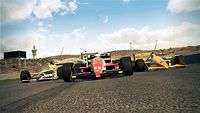 |
 |
 |
 |
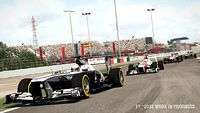 |
 |
Thanks to the changes in how the tyres degrade, the handling is much more pronounced than in earlier years; you’ll fight oversteer coming out of corners, battle with the rear-end and throw the chassis around like your life depends on it, and the act of racing has never felt more satisfying as a result. The handling changes are even more pronounced when using or disabling the various driving assists provided for you, but the core racing has never felt so finely honed or such a pleasure to drive.
 As for the assists, the familiar ability to flashback to several seconds previously to avoid crashing or earning a penalty makes a return, but with a change that will please less-skilled players and potentially annoy some of the more hardcore gamers. While racers will only be able to have a maximum of four flashbacks at once during a race – as before – any previously-used flashbacks will replenish after several laps if the player can make it through them without incident, providing a greater incentive to drive more cleanly, and this pays off in dividends when the tyres reach the cliff, forcing you and the grass to fight for custody of your vehicle.
As for the assists, the familiar ability to flashback to several seconds previously to avoid crashing or earning a penalty makes a return, but with a change that will please less-skilled players and potentially annoy some of the more hardcore gamers. While racers will only be able to have a maximum of four flashbacks at once during a race – as before – any previously-used flashbacks will replenish after several laps if the player can make it through them without incident, providing a greater incentive to drive more cleanly, and this pays off in dividends when the tyres reach the cliff, forcing you and the grass to fight for custody of your vehicle.
Additional flashbacks also help when you’re confronted against the rival AI, which is far more aggressive than it has been in previous years. For the most part, a more combative computer is actually a welcome challenge to the cars of before, seeing as they’d often charge into my rear, lose their front-wing and crash out. In F1 2013, other drivers will attempt overtakes more often and sometimes using racing lines you wouldn’t expect in their efforts to surpass you, but this doesn’t always work out for the best. In fact, I found more than a few moments where their attempts to overtake me would result in both of our cars being caught between each other and slowing down to such a degree that other drivers could easily zoom past us, and a handful of occasions where they’d smash me off the tarmac and into a spin with such force that I’m surprised nothing significant was damaged.
Actually, the damage system for this year’s iteration seems to be a bit more lackadaisical as, even with the setting on ‘realistic’, I could still bash into someone’s rear-wing and emerge entirely unscathed, or have someone crash into me and neither car receive any damage. Similarly, outside of the Scenario mode, I’ve yet to experience a single safety-car to spice things up or change up a strategy, and I’ve had a couple of races where I’d be given a rain warning and see drops fall to the track, but the downpour would never increase to the point I needed to use wet-weather tyres. An underrated addition is that of the Mid-Session Save, allowing players to take a breather in the middle of some of the longer races and return to it later, and makes F1 2013 a perfect choice to pick up and play whether you want to play for five hours or five minutes.
 A previous complaint of the series was that the difference between Intermediate and Professional was too extreme, and so Codemasters have inserted a new difficulty level between the two, allowing players to ramp up the challenge with a more balanced learning curve and come away less frustrated. For the most part, this extra difficulty mode strikes a good balance, but the problem arises from the fact that, although there are five difficulties to choose from (six, if you include the custom option that allows you to fine-tune the experience the way you want), the AI still only has the same four modes as before.
A previous complaint of the series was that the difference between Intermediate and Professional was too extreme, and so Codemasters have inserted a new difficulty level between the two, allowing players to ramp up the challenge with a more balanced learning curve and come away less frustrated. For the most part, this extra difficulty mode strikes a good balance, but the problem arises from the fact that, although there are five difficulties to choose from (six, if you include the custom option that allows you to fine-tune the experience the way you want), the AI still only has the same four modes as before.
As a result, the AI seems slightly inconsistent; I’ve had race weekends where I’ve blitzed the practice and qualifying sessions with laps up to two seconds faster than the rest of the field, only to have those rivals charge past me at the first corner and storm ahead to a three-second advantage within the first sector of the lap. Yet, I’ve also had times when I’ve been able to storm through the field after a pit-stop, pull up behind the race-leader and only lose ground if I misjudge a corner or have a particularly slow lap. When the AI wants to rubber-band you and speed off into the distance, it’ll do so without hesitation and think nothing of increasing the gap by up to four seconds a lap to boot. It’s a shame, because it’s the moments where the fight seems feasible and you’re trading tenths of a second with the driver in front that stand out most and provide the greatest memories; trading fastest laps with my team-mate Räikkönen at Nürburgring or chasing Hamilton at the Hungaroring until he made a mistake and fell off the track felt far more satisfying than finding myself clinching third in Monaco, only to discover Rosberg had won the race with forty seconds advantage over me.
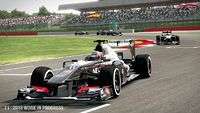 |
 |
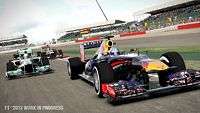 |
 |
 |
 |
Considering that this season of F1 has stagnated before the radical rule changes approaching next year, it would have been too easy for Codemasters to rest on their laurels and churn out more of the same, but instead they chose to see the current generation of the motorsport off with a bang. There’s plenty of new content to wade through, although not all of it pays off as well as you’d expect, with the much-hyped Classics mode feeling a bit bare-bones when confronted with just the eighties content. Scenario mode is far more entertaining and varied than last year’s Champions mode, the Young Driver’s Test is more important and doesn’t just feel like an enforced tutorial, and the Career mode is still a brilliant time-sink, even if it’s almost identical to F1 2012′s offering. The rubber-banding may sometimes be worse than ever, and the lack of damage to cars paired with often overly-aggressive AI can lead to frustrating moments, but rarely to a point where you’ll want to switch off. If you’ve played any of Codemasters’ previous attempts at the F1 franchise, there’s more than enough here to entice you into another lap, but if you’re yet to indulge in the series, there’s no better opportunity or greater swansong for this generation of the sport. Plus, it’s insanely cathartic to nudge Vettel off the track.
Pros- Greater handling and faster pace makes the action feel more intense and entertaining.
- Pirelli tyres make strategy more important and races more exciting.
- Scenario Mode allows for plenty of variety and incentives to pick up and play for shorter periods.
- Young Driver's Test feels more like an integral addition than a forced tutorial.
- Mid-Session saving allows the gameplay to feel more flexible.
- Classics Mode is a great addition that lets players relive the past in style.
- ...Although a lack of variety means you'll tire of it easily.
- Defending with worn Pirellis can be mildly frustrating at times.
- When the AI rubber-bands or speeds off into the distance, it's worse than ever before.
- Overly-aggressive AI can lead to incidents that aren't your fault.
- Career mode could do with an overhaul.
With two brand new modes and a familiar one being given a new shot in the arm, Codemasters have put their all into F1 2013, and it serves magnificently as both a swansong to the current generation of consoles and a sport undergoing a massive renovation next year. Familiar issues with rubber-banding and inconsistent AI arise, and some of the changes made haven't worked as well as they should, but it's still a marked improvement on previous years. Anyone who has played its predecessors shouldn't wonder if there's any point investing, as there's plenty of refinements, tweaks and new content to justify a purchase, while anyone who hasn't played an F1 game - whether in years or ever - will find it extremely difficult to do better than F1 2013.
Last five articles by Edward
- Best of 2015: Journey's End: A New Beginning
- Journey's End: A New Beginning
- You Can't Choose Your Happy Ending
- Okay, Let's Fix Comedy In Games - The V-Effekt
- Time Keeps On Smashing Away



























There are no comments, yet.
Why don’t you be the first? Come on, you know you want to!